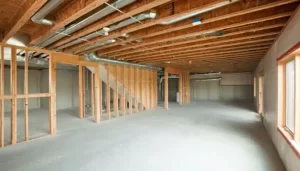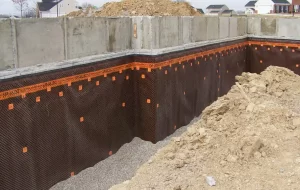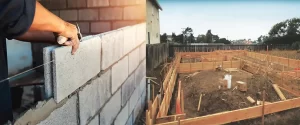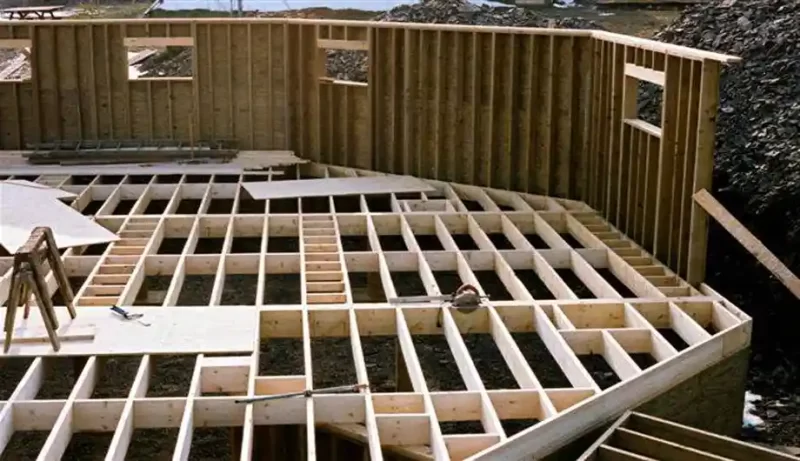Waterproofing your wood foundation walls is an important step in ensuring the longevity of your home. There are a few different ways to waterproof your foundation, but the most important thing is to ensure that you do it before any problems arise. The best time to waterproof your foundation is in the spring before the rainy season begins. Make sure to waterproof your foundation today and enjoy a worry-free rainy season!
In this post, we’ll discuss why waterproofing your foundation walls is so important, and we’ll also provide some tips on how to do it effectively.
How do you Waterproof Wood Walls?/ What can I use to Cover a Wood Foundation?

There are a few different ways to waterproof your wood foundation walls.
Installation of a Moisture Barrier for Wood Foundation
The most common method is to install a waterproofing membrane on the exterior of the foundation walls. This membrane can be made of plastic, rubber, or asphalt-coated fabric.
The membrane is applied to the foundation walls and then covered with a layer of waterproofing material, such as asphalt paper or tar paper. The waterproofing material helps to keep the membrane in place and provides an additional barrier against water.
Installation of Drain Tile
Another method of waterproofing your wood foundation walls is to install drain tile around the perimeter of the foundation. Drain tile is a perforated pipe that is placed in a bed of gravel at the base of the foundation walls.
The drain tile collects water that seeps through the foundation walls and carries it away from the home. This helps to keep the foundation walls dry and prevents water damage.
Installation of Waterproofing Paint
Another option for waterproofing your wood foundation walls is to apply waterproofing paint. This type of paint is specially formulated to create a waterproof barrier on the surface of the foundation walls.
Waterproofing paint is available in both oil– and water-based formulations. It can be applied with a brush, roller, or sprayer.
No matter which method you choose, waterproofing your wood foundation walls is an important step in protecting your home from water damage.
How to apply a water repellent to your wood foundation walls?

There are a few different ways to apply a water repellent to your wood foundation walls.
You can brush, roll, or spray the water repellent onto the surface of the walls.
If you are using a waterproofing paint, you can add the water repellent to the paint before you apply it to the walls.
Once the waterproofing material or paint has been applied, you should allow it to dry completely before waterproofing your wood foundation walls.
10 Benefits of waterproofing your wood foundation walls
Waterproofing your wood foundation walls is important for a number of reasons.
They’re relatively inexpensive
One of the biggest advantages of wood foundation walls is that they’re relatively inexpensive. When compared to other foundation materials such as concrete or masonry, wood is relatively inexpensive. This can be a great advantage if you’re on a tight budget.
They’re easy to work with
Another advantage of wood foundation walls is that they’re easy to work with. If you’re planning on doing the work yourself, wood is much easier to work with than other foundation materials. This can save you a lot of time and money.
They’re environmentally friendly
Wood is a renewable resource, which means that it is environmentally friendly. If you’re looking for a way to be more eco-friendly, using wood foundation walls is a great option.
They’re durable
When properly cared for, wood foundation walls can be very durable. This means that they will last for many years, which can save you money in the long run.
They resist rot and decay
Wood is naturally resistant to rot and decay, which means that it won’t break down as easily as other foundation materials. This can help to extend the life of your foundation.
They’re easy to repair
If you do experience any problems with your wood foundation walls, they’re relatively easy to repair. This can save you time and money in the long run.
They offer good insulation
Wood is a good insulator, which means that it can help to keep your home warm in the winter and cool in the summer. This can save you money on your energy bills.
They’re fire resistant
Wood is naturally fire resistant, which means that it won’t catch fire as easily as other foundation materials. This can help to keep your home safe in the event of a fire.
They’re termite resistant
Wood is naturally resistant to termites, which means that you won’t have to worry about them damaging your foundation. This can save you a lot of money in the long run.
Waterproofing your wood foundation walls is an important step in protecting your home from water damage. There are a number of benefits to waterproofing your wood foundation walls, including the fact that they’re relatively inexpensive, easy to work with, durable, and easy to repair. If you’re looking for a way to protect your home from water damage, waterproofing your wood foundation walls is a great option.
Now that we’ve discussed the importance of waterproofing your wood foundation walls, let’s look at some tips on how to do it effectively.
Tips and tricks for ensuring long-term success with waterproofing you
There are a few key things to keep in mind when waterproofing your wood foundation walls even if you’re working with a waterproofing professional. By keeping these things in focus, you can help to ensure that your waterproofing efforts are successful and long-lasting.
Proper installation
First, it’s important to make sure that the waterproofing membranes used are properly installed. If there are gaps or leaks in the membrane, water will be able to get through and cause damage.
The right products
Second, you need to use the right products for waterproofing your wood foundation walls. There are a lot of different waterproofing membranes on the market, but not all of them are created equal. Work with a waterproofing professional to find the right products for your specific needs.
Regular maintenance
Third, waterproofing is not a one-time job. In order to keep your wood foundation walls waterproofed, you need to perform regular maintenance. This may include checking for and repairing any leaks or damage as soon as possible.
Make sure the surface is clean and dry before waterproofing- Apply waterproofing in a thin, even coat- Let the waterproofing dry completely before applying paint or another finish. If you follow these tips, you can ensure that your waterproofing job is successful and long-lasting.
Is wood foundation bad?
There is no simple answer to this question, as it depends on a number of factors including the climate where you live and the design of your home. In general, however, a wood foundation can be a bad idea in areas where there is a lot of moisture or where there is a risk of termites. If you are unsure whether or not a wood foundation is right for your home, it is always best to consult with a professional.
What Are the Risks of a Wood Basement and What Should You Know About It?
There are a few drawbacks to utilizing wood foundation walls in your house. The following are some of the most significant ones.
Regular maintenance is a must.
Wood foundation walls require regular maintenance in order to stay waterproofed. If you don’t perform regular maintenance, the wood foundation walls may become damaged and allow water to enter the home. You should check for damage regularly and repair any leaks or gaps as soon as possible.
They’re not as strong as other foundation materials.
Wood foundation walls are not as strong as concrete or masonry foundation walls. They may be more likely to sustain damage in the event of a natural disaster such as an earthquake or hurricane.
They’re susceptible to rot and decay.
Wood is a natural material, and it is susceptible to rot and decay. If the wood foundation walls are not properly maintained, they may eventually succumb to rot and decay. This can cause serious damage to the home.
They’re a fire hazard.
Wood is a flammable material, which means that it can be a fire hazard. If you have a wood foundation, it is important to take measures to protect the home from fire. This may include installing fire sprinklers and smoke detectors.
What is the waterproofing wood foundation walls cost
Waterproofing wood foundation walls can be a relatively expensive project, but it’s important to consider the long-term benefits. The cost of waterproofing will depend on the method you choose and the size of your foundation. If you’re interested in waterproofing your wood foundation walls, contact a professional contractor for a quote. They will be able to assess your foundation and provide you with an estimate of the cost.
While waterproofing your wood foundation walls is an important investment, it’s nothing compared to the cost of repairing water damage. Waterproofing your foundation will help to prevent expensive repairs down the road and will extend the life of your home.
Frequently Asked Questions:
How do you waterproof a basement floor?
Waterproofing your basement floor is an important part of keeping your home dry and free of mold and mildew. There are a few different ways to waterproof your basement floor, but the most important thing is to make sure that the surface is clean and dry before you begin.
One way to waterproof your basement floor is to apply a waterproofing sealer. This can be done with a brush or roller, and it will create a barrier that will prevent water from seeping through.
Another way to waterproof your basement floor is to install a drainage system. This will allow any water that does seep through to be directed away from the home.
No matter which method you choose, it is important to make sure that the surface is clean and dry before you begin. This will ensure that the waterproofing sealer or drainage system can do its job properly.
What is the waterproofing wood foundation walls cost?
Waterproofing wood foundation walls can be a relatively expensive project, but it’s important to consider the long-term benefits. The cost of waterproofing will depend on the method you choose and the size of your foundation. If you’re interested in waterproofing your wood foundation walls, contact a professional contractor for a quote. They will be able to assess your foundation and provide you with an estimate of the cost.
While waterproofing your wood foundation walls is an important investment, it’s nothing compared to the cost of repairing water damage. Waterproofing your foundation will help to prevent expensive repairs down the road and will extend the life of your home.
Which foundation wall is better for you: concrete or wood?

Cost
Wood foundation walls are generally less expensive than concrete foundation walls. This is because they are made from a natural material, and they do not require as much labor to install.
Strength
Concrete foundation walls are stronger than wood foundation walls. This is because concrete is a much more dense and durable material. If you live in an area with a lot of seismic activity, or if you are worried about your home sustaining damage in the event of a natural disaster, concrete foundation walls may be a better option.
Moisture Resistance
Wood is a natural material, and it is very resistant to moisture. This means that wood foundation walls are a good choice for homes in areas with high humidity or a lot of rainfall.
Fire Resistance
Concrete is non-flammable, which means that it is a better choice than wood if you are worried about fire safety.
Termite Resistance
Wood is also resistant to termites, which means that it is a good choice for homes in areas where these pests are common.
So, which is better? Concrete or wood foundation walls? The answer to this question depends on your specific needs and preferences. If you are concerned about cost, then wood foundation walls may be the best option. If you are concerned about strength and durability, then concrete foundation walls may be the better choice. Ultimately, the decision is up to you.
Concluding Remarks
Now that you know the basics of waterproofing your wood foundation walls, it’s time to get started. The best way to do this is by hiring a professional contractor who has experience with waterproofing foundations. They will be able to inspect your home and recommend the right solution for your needs. If you decide to take on this project yourself, make sure you do your research and follow all the steps we outlined above.
In this article, we’ve outlined the reasons why you need to waterproof your foundation and how to do it. We’ve also shared a few tips on choosing the right waterproofing products for your needs. If you have any questions about waterproofing your foundation, feel free to ask in the comments section below.
Thanks for reading! We hope this article has been helpful.


0 thoughts on “Waterproofing Your Wood Foundation Walls: A Beginner’s Guide”